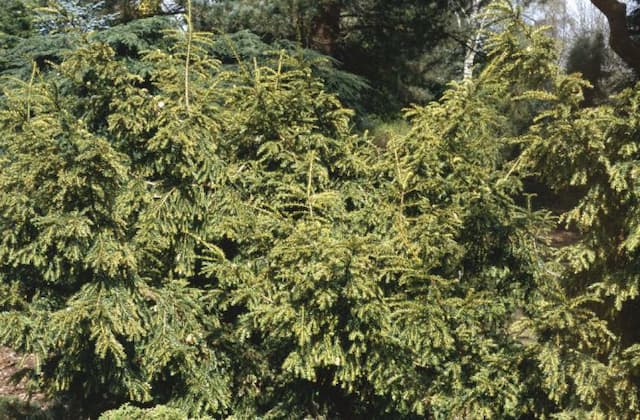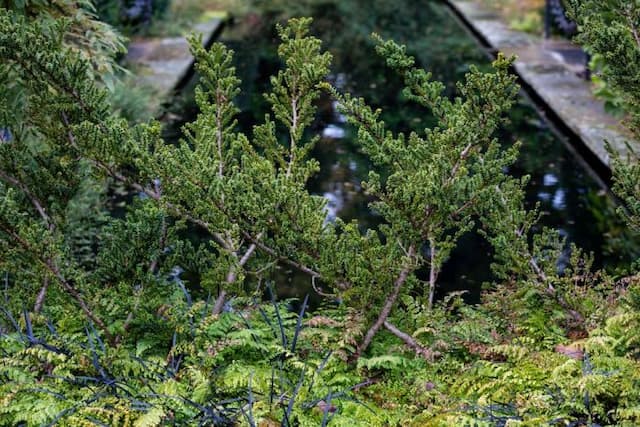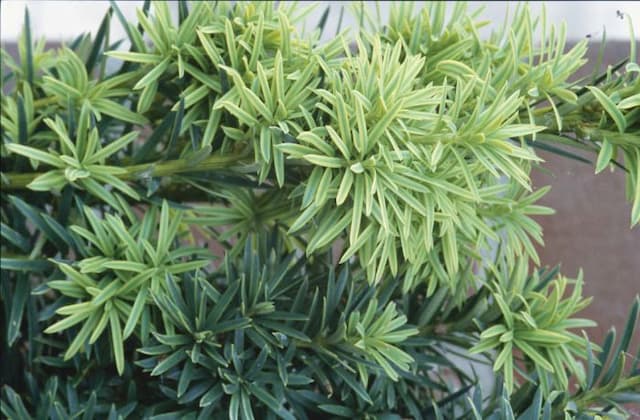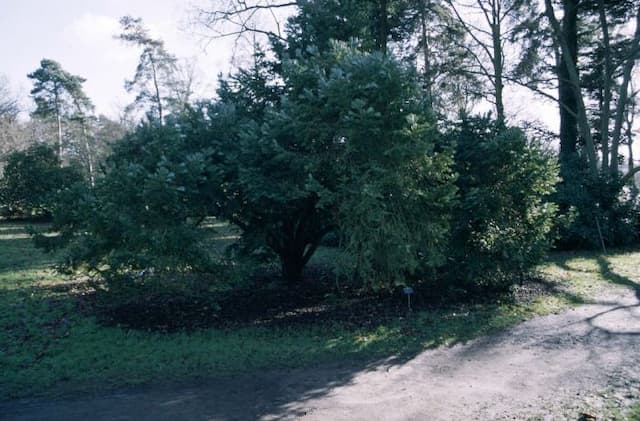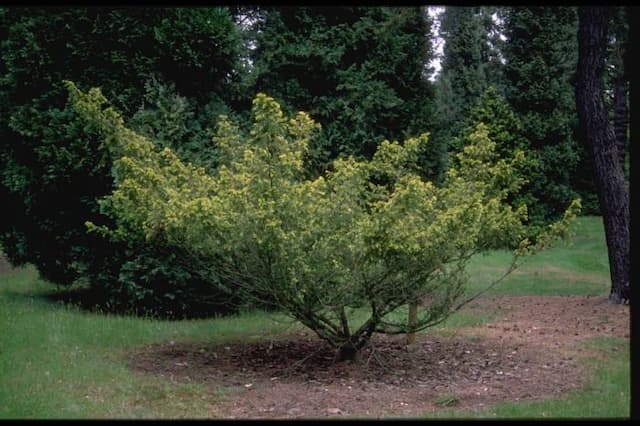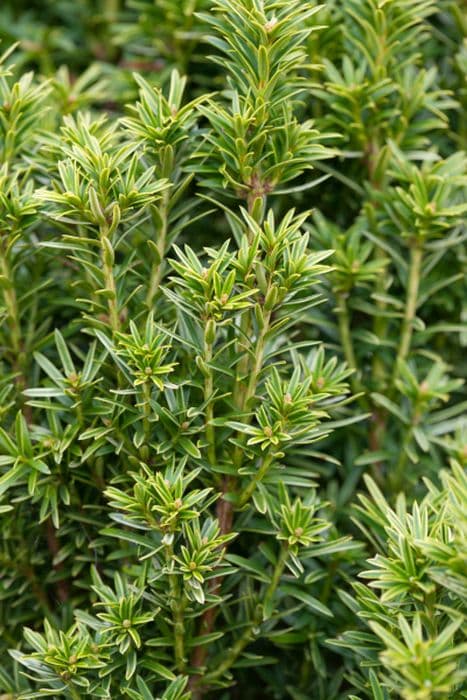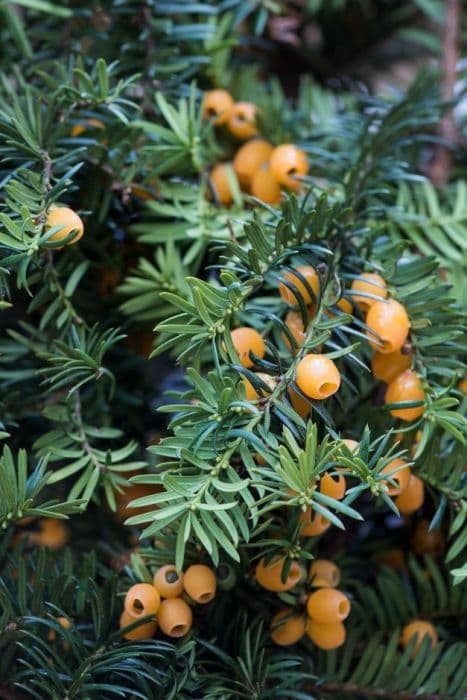English yew Taxus baccata 'Repandens' (f)

ABOUT
The European Yew 'Repandens' is a striking evergreen plant renowned for its distinctive form and foliage. The plant features a spreading habit with branches that gently arch downwards, giving it an elegant and graceful appearance. Its needles are dark green, small, and arranged in a spiral fashion around the branches, which adds a rich texture to the overall look of the plant. During certain times of the year, this variety of European Yew produces small, inconspicuous flowers that are typically not a major focal point for the species. However, the plant can also bear bright red, berry-like structures that add a splash of color against the dark green needles. These are particularly attractive and can be quite noticeable. Despite being called berries, these are actually modified cones with a fleshy covering, which is a characteristic feature of this plant variety. Overall, the European Yew 'Repandens' is appreciated for its lush, evergreen foliage and its ornamental berries, providing visual interest throughout the year. It's a cultivar that can complement a variety of landscapes and garden styles without drawing much attention to its size, instead offering a touch of elegance and color.
About this plant
 Names
NamesFamily
Taxaceae.
Synonyms
English Yew, European Yew, Spreading Yew.
Common names
I do not have any scientific synonyms listed for Taxus baccata 'Repandens' (f), therefore the basic scientific name remains Taxus baccata 'Repandens'.
 Toxicity
ToxicityTo humans
The common name for Taxus baccata 'Repandens' (f) is English Yew. The English Yew is highly toxic to humans. All parts of the plant are poisonous, especially the seeds inside the berries. Ingesting parts of this plant can lead to symptoms such as dizziness, dry mouth, dilated pupils, nausea, abdominal pain, difficulty in breathing, and a potentially fatal change in heart rate. The poison can have a sedative effect on the heart, potentially leading to life-threatening complications. Consumption of even a small quantity of the foliage or seeds can be dangerous, and immediate medical attention should be sought if ingestion is suspected.
To pets
The common name for Taxus baccata 'Repandens' (f) is English Yew. The English Yew is highly toxic to pets, including dogs and cats. All parts of the plant contain toxic alkaloids, with the seeds within the berries being particularly dangerous. If a pet ingests any part of this plant, symptoms can occur rapidly and may include vomiting, diarrhea, difficulty breathing, trembling, weakness, changes in heart rate, and potentially heart failure. In severe cases, ingestion can be fatal. Due to its high toxicity, any suspected consumption of English Yew by a pet should be treated as a veterinary emergency.
 Characteristics
CharacteristicsLife cycle
Perennials
Foliage type
Evergreen
Color of leaves
Dark green
Height
2-3 feet (0.6-0.91 meters)
Spread
4-6 feet (1.2-1.8 meters)
Plant type
Shrub
Hardiness zones
6-9
Native area
Europe
Benefits
 General Benefits
General Benefits- Ornamental Value: The English Yew 'Repandens' is highly valued for its attractive, dark green foliage and spreading habit, making it a popular choice for landscape design.
- Low Maintenance: This plant is relatively low maintenance, requiring minimal pruning and care once established, making it ideal for busy gardeners.
- Drought Resistance: It is known for its ability to withstand periods of drought, which is beneficial in areas with water restrictions or less frequent rainfall.
- Erosion Control: The spreading and dense growth habit of 'Repandens' helps stabilize soil and prevent erosion on slopes and banks.
- Habitat for Wildlife: The dense foliage provides shelter for birds and other wildlife, while the red arils (not the seeds within) offer a food source.
- Privacy Screen: The thick foliage and spreading form make it an excellent choice for creating privacy screens or hedges in the landscape.
- Shade Tolerance: English Yew 'Repandens' can thrive in shaded areas where other plants may struggle, increasing its versatility in the garden.
- Longevity: This cultivar of English Yew is known for its long lifespan, adding permanence and stability to garden settings.
 Medical Properties
Medical Properties- This plant is not used for medical purposes.
 Air-purifying Qualities
Air-purifying QualitiesThis plant is not specifically known for air purifying qualities.
 Other Uses
Other Uses- Woodworking: Yew wood is highly valued for its hard, fine grain and is often used for making furniture, cabinetry, and archery bows.
- Dye Production: The bark and needles of the yew can be used to produce natural dyes for textile coloring.
- Ornamental hedging: Due to its dense foliage, the yew is a popular choice for ornamental hedges and topiaries in gardens and parks.
- Wildlife Shelter: The thick canopy of the yew can provide shelter to birds and other small wildlife seeking refuge or nesting spaces.
- Garden Sculpture: With its ability to tolerate heavy pruning, the yew is often shaped into garden sculptures or living fences.
- Christmas Decoration: Yew branches may be used as greenery in Christmas decorations or wreaths during the holiday season.
- Soil Stabilization: Yew's extensive root system can help prevent soil erosion on slopes and in areas where ground cover is needed.
- Windbreaks: The dense nature of yew hedges makes them effective as windbreaks, protecting more sensitive plants and reducing wind erosion.
- Cultural Symbolism: In some traditions, yew trees are planted in sacred sites or cemeteries, symbolizing immortality and the eternal cycle of life.
- Survival Tool: The wood of the yew can be used in survival situations to start fires by friction, especially if the wood is dry.
Interesting Facts
 Feng Shui
Feng ShuiThe English Yew is not used in Feng Shui practice.
 Zodiac Sign Compitability
Zodiac Sign CompitabilityThe English Yew is not used in astrology practice.
 Plant Symbolism
Plant Symbolism- Eternal Life: Taxus baccata, commonly known as Yew, has long been associated with immortality and eternal life due to its longevity and evergreen nature.
- Transition and Transformation: Because Yews can live for thousands of years, they often symbolize change and the passage of time, as well as the transformation of the soul.
- Protection: Yew trees have been planted in graveyards, throughout Europe particularly, symbolizing a protective barrier between the living and the dead.
- Resilience and Tenacity: Due to its hardy nature and ability to withstand harsh conditions, Yew is often seen as a symbol of resilience and tenacity in the face of adversity.
 Water
WaterThe English yew 'Repandens' should be watered deeply but infrequently to encourage root development, with a generous amount of water every couple of weeks during dry periods. Typically, the mature plant will thrive with about 1 inch of water weekly, which equates to roughly 0.6 gallons per square foot of soil area. When the plant is active in spring and summer, monitor soil moisture to maintain slightly moist conditions; overwatering can lead to root rot. Reduce watering frequency in the fall and winter months when the plant's growth slows down.
 Light
LightEnglish yew 'Repandens' thrives in partial to full shade but can tolerate a wide range of lighting conditions. The ideal spot for this plant is an area that receives dappled sunlight or light shade to protect it from the intense afternoon sun. If it's possible to provide some morning sun followed by shade or filtered light for the rest of the day, the plant would find this optimal.
 Temperature
TemperatureThe English yew 'Repandens' is very hardy and can withstand temperatures ranging from -30 to 100 degrees Fahrenheit. It prefers a temperate climate but can survive brief temperature extremes beyond this range. Ideally, maintaining a temperature between 60 and 70 degrees Fahrenheit would promote healthy growth.
 Pruning
PruningPrune English yew 'Repandens' to maintain its shape and health, focusing on removing dead or damaged branches and shaping the plant as needed. The best time for pruning is in the late winter or early spring before new growth begins. It's recommended to perform light pruning annually, but a more thorough trim can be done every 2-3 years to rejuvenate older plants.
 Cleaning
CleaningAs needed
 Soil
SoilSpreading English Yew requires well-drained, fertile soil with a pH between 6.0 and 7.5. A mix of loamy soil, peat, coarse sand, and a bit of compost is ideal for healthy growth.
 Repotting
RepottingSpreading English Yew trees are slow-growing and do not need frequent repotting. Repot every four to five years or when the tree outgrows its pot.
 Humidity & Misting
Humidity & MistingSpreading English Yew prefers moderate to high ambient humidity but is quite adaptable and can tolerate lower levels without issue.
 Suitable locations
Suitable locationsIndoor
Place in bright, indirect light; water when topsoil is dry.
Outdoor
Needs partial to full sun, shelter from strong winds, and well-drained soil.
Hardiness zone
6-7 USDA
 Life cycle
Life cycleThe Taxus baccata 'Repandens', commonly known as the Spreading English Yew, begins its life as a seed, which after a period of dormancy, usually requires stratification to break dormancy and germinate. Once sprouted, the seedling develops into a juvenile plant, characterized by fast-paced, upright growth and the development of its needle-like foliage. As the juvenile plant matures, it enters the adult vegetative stage, where it exhibits a spreading habit and continues to grow in girth and density, producing stiff, dark green needles and sometimes turning slightly procumbent. This stage can last for several decades due to the slow-growing nature of yews. The plant then reaches reproductive maturity, developing inconspicuous male or female reproductive structures depending on its sex; in the case of a female plant, it produces red arils that contain the seeds after pollination. The Spreading English Yew is a long-lived species, potentially reaching several hundred years in age, and may eventually decline due to environmental factors, age-related stress, or disease, completing its life cycle.
 Propogation
PropogationPropogation time
Late summer to early autumn
English Yew 'Repandens' is typically propagated through semi-hardwood cuttings. The best time for taking cuttings is during the late summer to early fall. To propagate, one should select healthy, disease-free branches and cut segments that are about 6 to 8 inches (15 to 20 centimeters) long, making sure each cutting has at least two to three sets of leaves. The bottom cut should be made just below a node, and the lower leaves should be removed. The cut end is then dipped in rooting hormone to encourage root development and planted in a well-draining soil mix. Cuttings need to be kept moist and in a sheltered location with indirect light until roots have formed, which typically takes a few months. It is also helpful to cover the cuttings with a plastic bag or place them in a cold frame to maintain high humidity.
